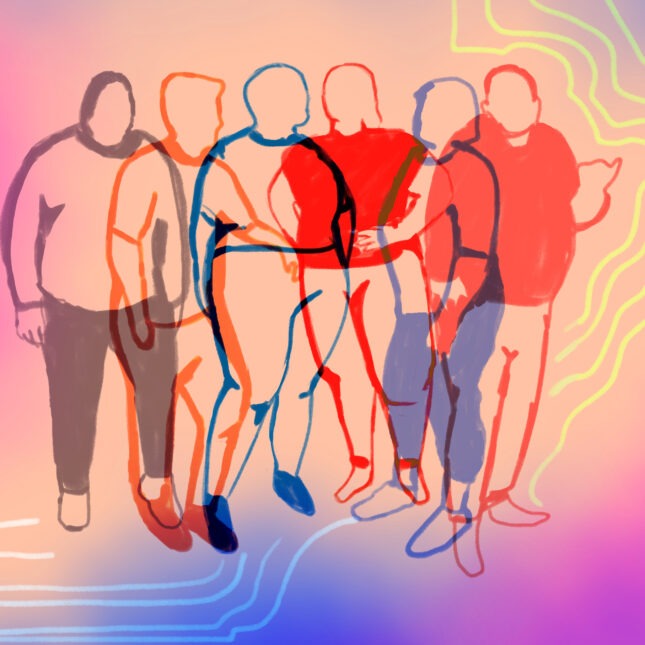Injury as a consequence of trauma
Trauma as a consequence of trauma is something that is not talked about much. Trauma, which is often talked about in terms of physical health, is deeply intertwined with psychological factors that can transform it into a form of trauma. Despite the visible consequences of excessive stress, grief can function as a protective mechanism, shielding individuals from emotional pain, vulnerability and the complexity of human relationships. Seen through this prism, grief is not just a medical condition, but rather the manifestation of multiple psychological wounds that require recognition and understanding.
For some bodies, it becomes a battleground on which trauma can manifest itself. In this context, trauma can be understood as a response to emotional wounds, where the body uses itself to create a barrier between itself and the outside world. This barrier has a dual purpose: it can protect the individual from unwanted attention, protect them from potential relationship problems and provide a sense of control in an otherwise uncontrollable emotional landscape.
For individuals who have experienced relationship trauma, especially in the formative years, the idea of intimacy can be fraught with fear and anxiety. Relationships demand vulnerability, openness and the risk of being hurt. For some people who have been deeply violated in the past, these aspects of human connection may seem too dangerous to be managed. Here, pain can become a subconscious strategy for avoiding this danger. By creating a physical form that is considered less desirable or less likely to evoke closeness, the individual protects himself from potential rejection, betrayal or harm that could come with intimacy. Weight becomes a literal and figurative shield, isolating them from the emotional risks of getting close to others.
Moreover, the social stigma surrounding homosexuality can strengthen this protective mechanism. In many cultures, individuals with a larger body are often marginalized, judged or rejected. Although this stigmatization is negative, paradoxically it can serve as a protective measure for someone who is afraid of connecting with the world. The judgment and exclusion that come with being violent can create a feeling of security in isolation—confirming the individual’s belief that the world is a dangerous place and increasing their need to remain distant and unseen.
The Healing Power of Saying ‘This Hurt Me’
In this sense, fear is not just a physical but also a psychological state. It is a way of controlling interaction, a way of dictating the terms of engagement with others. The urge may be to say, “Submit” or “I’m not available for a relationship,” but the person does not have to verbalize these fears. It can create a feeling of power in the face of past experiences in which the individual felt powerless.
This use of pain as a protective mechanism can also be linked to the concept of self-sabotage. By avoiding relationships, situations and full involvement in life, individuals may be instinctively protecting themselves from the possibility of failure or further trauma. Stress can be a way of ensuring that they never have to face these fears, that they never have to risk being hurt again. It is a way of working in a safe, controlled space, even if that space is ultimately restrictive and restrictive in other ways.
However, this protection strategy comes at a significant cost. While it can protect the individual from perceived dangers, it also isolates them from the joy of connection, the fulfillment of deep relationships and the richness of a fully engaged life. The prestige that suffering can bring can become a trap, trapping individuals in a circle of loneliness, self-criticism and long-term emotional pain. The very thing that needs to be protected can end up causing more harm, prolonging the trauma that it was supposed to protect against.
Understanding pain as a response to trauma requires empathy and a change in the way we approach weight and health. It calls for the recognition that the body, in all its manifestations, tells a story – a story of pain, fear, protection and survival. Therefore, the resolution of pain cannot be limited to nutrition and medication. This requires a dual investigation of the emotional and psychological aspects that trigger such behavior. In this context, healing from pain means healing from the trauma that lies behind it. It involves creating a space in which the individual can feel safe enough to let go, risk vulnerability and engage with the world in a healthy and fulfilling way.
Finally, grief as a form of psychological trauma reflects a complex interaction between the body and the mind. It is a response to deeply rooted fears, a protective measure against emotional pain and a way of recognizing a world that seems unsafe. Recognizing this link is key to addressing the root causes of violence and providing support to individuals on their path to healing and wholeness.

Keywords: Pretilost kao posljedica traume, debljina, somatic experiencing terapija, psihoterapeut zagreb, geštalt terapija, Licensed therapist near me in Manhattan NYC, Affordable therapy services in New York State, Holistic psychotherapy sessions in NYC, Somatic Experiencing therapy for trauma recovery in New York City, NARM therapy in Brooklyn, Licensed couples therapy in Manhattan, Gestalt therapy near me in NYC, Marriage counseling in Queens NYC, Therapy for anxiety treatment in NYC, Experienced psychotherapist in New York, Licensed psychotherapist near me in NYC, Somatic Experiencing therapy sessions in New York, Trauma therapy and counseling in Manhattan, Gestalt therapy sessions in New York City, Therapy sessions for emotional regulation in New York, Trauma therapy near me in Brooklyn New York, Licensed mental health therapist in Manhattan NYC, Depression therapy in New York, New York City therapist experienced in PTSD treatment
*Photo: GettyImages
*Contact: Dogovori termin
*For companies: https://creativemanager.eu
Why You Struggle to Ask for Help (Even When You Need It)









